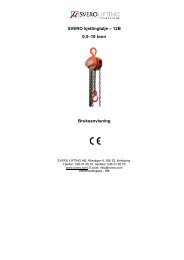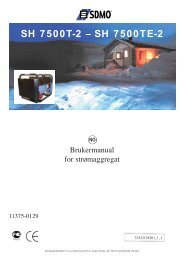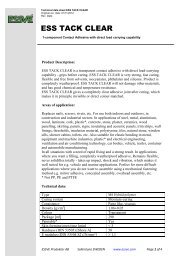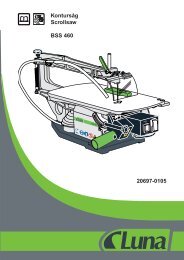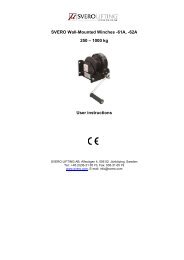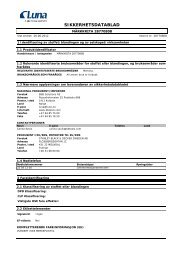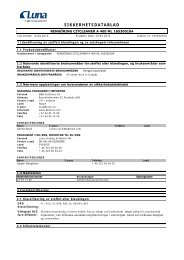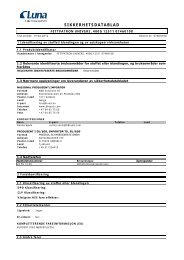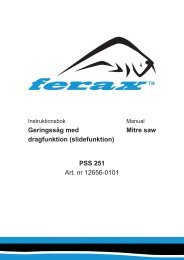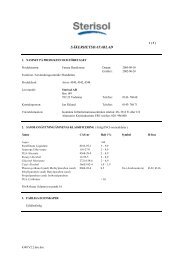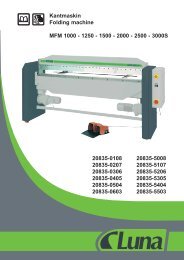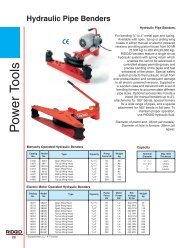Bandslipmaskin Belt Grinding Machine BBD 150 20645-0108
Bandslipmaskin Belt Grinding Machine BBD 150 20645-0108
Bandslipmaskin Belt Grinding Machine BBD 150 20645-0108
You also want an ePaper? Increase the reach of your titles
YUMPU automatically turns print PDFs into web optimized ePapers that Google loves.
INSPECT YOUR WORKPIECE<br />
CAUTION! Make sure there are no nails or foreign objects in the<br />
part of the work piece to be sanded.<br />
Plan your work to avoid THROWBACKS when the work piece<br />
catches the sanding belt or disc and is torn from your hands.<br />
• Make sure there’s no debris between the workpiece and its supports.<br />
• When sanding irregularly shaped workpieces, plan your work<br />
support so it will not slip and be pulled from your hands.<br />
• Use extra caution with large, very small or awkward workpieces.<br />
• Never use this tool to finish pieces too small to hold by hand.<br />
• Use extra support (tables, saw horses, blocks, etc.) for any workpieces<br />
large enough to tip when not held down to the table top.<br />
• Never use another person as a substitute for a table extension, or<br />
as additional support for a workpiece that is longer or wider than<br />
the basic sander table, or to helt feed, support, or pull the workpiece.<br />
• When finishing on the disc, always press the workpiece against<br />
the “down” side of the disc. Sanding against the side coming up<br />
from under the table could damage the work by making it “chatter”,<br />
or tear the work from your hands and throw it.<br />
• Sand only one workpiece at a time.<br />
• Clear everything except the workpiece and rated support devices<br />
of the table before turning the sander on.<br />
Plan the way you will hold the workpiece from start to finish.<br />
Avoid awkward operations and hand positions where a sudden slip<br />
could cause fingers or hand to move into a sanding surface. Keep<br />
fingers away from where the belt goes into the dust trap.<br />
DONT’T OVERREACH. Keep good footing and balance.<br />
Keep your face and body to one side, out off line with a possible<br />
throwback.<br />
WHEN SANDER IS RUNNING<br />
WARNING! Don’t let familiarity (gained from frequent<br />
use of your belt and disc sander) cause a careless mistake.<br />
A careless fraction of a second is enough to cause a severe injury.<br />
Before starting your work, watch the sander while it runs. If it<br />
makes an unfamiliar noise or vibrates a lot, stop immediately. Turn<br />
the sander off. Unplug the sander. Do not restart until finding and<br />
correcting the problem. Make sure the sanding disc turn counterclockwise<br />
KEEP CHILDREN AWAY. Keep all visitors a safe distance from<br />
the sander. Make sure bystanders are clear of the sander and workpiece.<br />
DON’T FORCE TOOL. It will do the job better and safer at its<br />
designed rate. Press the workpiece against the sanding material<br />
only hard enough to let it sand without bogging down or binding:<br />
• Turn the switch “OFF”.<br />
• Unplug the sander<br />
• Wait for all moving parts to stop.<br />
BEFORE LEAVING THE SANDER:<br />
NEVER LEAVE TOOL RUNNING UNATTENDED. TURN<br />
POWER OFF. Don’t leave tool until it comes to a completed stop.<br />
MAKE WORKSHOP CHILDREN PROOF. Lock the shop.<br />
Disconnect master switches.<br />
44<br />
BEVEL SANDING<br />
The work table can be tilted from 0° to 45° for bevel sanding.<br />
Loosen the table lock knob and tilt the worktable to desired as<br />
shown. Retighten table lock knob.<br />
Table lock knob<br />
Table<br />
WARNING!<br />
To avoid trapping the work or fingers between the table and<br />
sanding surface, the table should repositioned on the table support<br />
to retain a maximum 2 mm distance between sanding surface and<br />
table.<br />
<strong>Belt</strong> bed<br />
Work Support<br />
Sanding surface<br />
2 mm max<br />
Table<br />
POSITIONING BELT BED<br />
A bed locking hex socket head screw locks the belt bed in a vertical<br />
or horizontal position.<br />
To adjust vertical position:<br />
1. Remove the work support.<br />
2. Loosen the hex socket head locking screw using a 6 mm hex<br />
wrench.<br />
Hex“L”Wrench<br />
3. Position belt bed vertically as shown and tighten the hex socket<br />
head locking screw.



